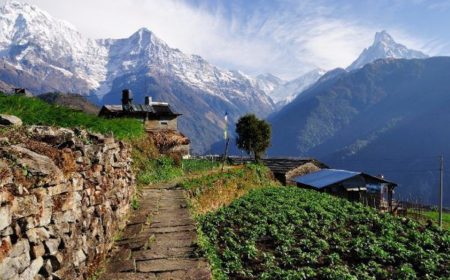
The Azores are Shangri-La, a remote mythical paradise that few know about and fewer have visited. The Portuguese islands in the middle of the Atlantic Ocean offer a stunning backdrop for outdoor adventure. White waterfalls gush down green mountains to land in clear blue pools. Hot springs bubble up through the black rock, luring travelers to jump in. The fertile volcanic soil yields lush vegetation, and a bounty of exotic indigenous foods—from tea to pineapple—not grown on the European mainland. Water species thrive as well, putting it high on world lists for scuba diving and whale-watching.
Unlike the characters in Lost Horizons, who disappeared in the Himalayas to find their utopia, the modern-day Shangri-La is much easier to attain. Whether arriving from New York, Boston, Lisbon, or London, the Azores tempt for a long weekend visit. Dive into Azorean water and culture on Sao Miguel, the largest and liveliest island.

The tiny capital, Ponta Delgada, lies just a few hundred feet from the airport runways. Literally–the runway ends and the main street begins. The quaint little capital recalls perhaps the 1960s more than the present, with its old buildings, relaxed pace, and general lack of pretension. It’s easily walkable in a day, and a self-guided walking tour is a perfect way to shed jet lag in the afternoon. The indispensable Bradt guidebook to the Azores includes a nifty two-hour tour.
Begin at the classic Hotel Talisman for a fine example of Portugal’s love affair with Art Deco. The rooftop pool offers wondrous views of the city so click away. Have lunch at its Palm Terrace restaurant or any of the neighborhood cafes, then stroll in the adjacent garden Jardim Padre Sena Freitas. Note the intense sky blue government building at one end, and the massive street art in the large public square.
Slipover to the museum to view works by the Azores most noted sculptor, Canto de Maia. The entire city celebrates art and has a young, dynamic vibe despite the Old World influences. Arco 8 is a lively art gallery/bar open weekends only. The growing Tremor Music Festival put the island on the indie music map. Festival followers should book their trip around this massive party.
A stroll down to the water reveals more street art everywhere. Travessa do Arco hosts a gigantic whale mural along with tic tac toe games that seem to never end. Enjoy the sea view while walking to the original 18th-century city gates that form the familiar triptych design found at every souvenir shop. These gates previously opened onto the port until the area was filled in to create a bustling square.

Wandering aimlessly is also highly recommended. Get lost in fragrant, colorful gardens, peek into shadowy but decorative churches, pose by the many sculptures, and pop into local shops for artisan goods. Food makes for a great walking tour as well and an excuse to experience uniquely local flavors.
Ponte Delgada offers international food options but sticks to the local classics. A Tasca is a bustling bistro with hip staff, craft beer, and innovative petiscos (Portuguese tapas). Restaurante Nacional is the best of the old-school eateries, serving tender local beef, farm-fresh produce, and freshly caught fish since 1947. Don’t forget to taste the famous black pudding with pineapple. Mane Cigano is the islands’ foremost griller of sardines, indulge on these and other delicacies for a pittance.
Restaurant Sao Pedro is another locals’ favorite specializing in the island’s vast assortment of fresh seafood, but the real draw is the mesmerizing video playing on repeat. Owner João Chaves has produced a dazzling one-hour long video tribute to the island, replete with aerial footage, extras, and CGI. Interested diners who ask politely might just receive a souvenir DVD with dessert.
Boutique hotel aficionados should check out Hotel do Colegio, on a well-situated side street by the Museu Carlos Machado. The interior features the repurposed elegant convent style while the staff is friendly and full of suggestions. Next door, the decades-old jazz club is being replaced by a taproom, the slightest evidence of change in this isolated time capsule.
Time to hop in a Smart Car and drive out to the Azores’ famously magnificent countryside. Nowhere is this more evident or spectacular then Sete Cidades, two freshwater lakes atop a lava dome, one clearly green and the other blue. The drive itself is a delight, winding and verdant, bursting with hydrangeas. Numerous vistas circle the rim of the crater, many of which offer opportunities to hike and bike. The tiny village down in the crater is worth the visiting for its old church and colorful, well-kept houses.
After lunch, it’s time for a dip. Continuing to the island’s westernmost point, the Termas da Ferraria provide a wild, warm swim. Set at the bottom of a steep drive followed by steps down through the black volcanic rock, this natural hot spring lures weary muscles to the edge of the ocean. The warm and cool waters mix together in a unique mélange, while a crisscross of ropes allows for safe, easy movement around the “pool”. Swim out to the edge of the open ocean to cool down and then tightrope back to the haven of heated thermal waters. The setting and experience are magical.
For a more private option, pay a small fee and soak in the man-made heated pool adjacent to the on-site high-end spa. The spa provides all the amenities, including treatments, massage, and an upscale restaurant while the pool is flanked by bars, bands, and DJs.
For another memorable day trip, Ilheu de Vila Franca do Campo is a postcard-perfect semi-circle atoll just off the coast. Guests can stroll and hike the islet and bask upon its sandy beach. Small, fast ferries go out at regular intervals, but the number of visitors is capped daily. Provided a picnic basket accompanies visitors, there is very little reason to leave until the last boat returns at sunset. Be on one of the early ferries at high season if the islet is a priority.
A fun alternative swim for latecomers awaits in nearby Caloura. The protected cove sits beneath a beautifully restored convent. Jump into the crystal blue waters before adjourning to the adjacent Bar Caloura. Dine on fresh-caught octopus, grilled mackerel washed down with crisp vinho branco from the Azorean island of Pico. The local cheeses and fresh bread make it an abundant feast. The setting says South of France; the prices say savor it while it remains undiscovered.
Furthest afield but still less than an hour from the capital, the village of Furnas offers garden-lovers a treat. The name suggests heat, and the hot pools of Furnas are a must. The Terra Nostra Garden is the most ornate of several classically manicured English gardens that grace the Azores. Visitors should make time for a Cozido Das Furnas, a slow pressure-cooked meal baked in the caldeira itself. Local restaurants sink gigantic baskets of meat, fish, and potatoes into the earth then cook them for 12 hours. The result is a picnic unlike any other, and culinary travel experience to remember.
When the time comes to leave Sao Miguel, be content knowing there are eight other islands to visit. The Azores will always be a destination unlike any other, but now is the time to experience Shangri-La in its pristine state.
By Greg Freitas and Natalie Compagno



